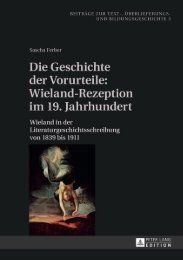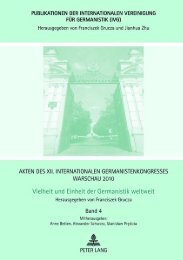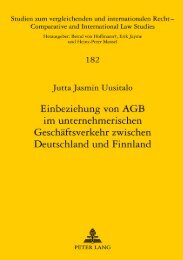Extract (PDF) - Peter Lang
Extract (PDF) - Peter Lang
Extract (PDF) - Peter Lang
You also want an ePaper? Increase the reach of your titles
YUMPU automatically turns print PDFs into web optimized ePapers that Google loves.
12 Fernanda Peñaloza<br />
and collective memories are intertwined with the founding myths of the<br />
colony, including the initial trek in 1865 from the Atlantic port of New Bay<br />
South to the river Chubut, the first contacts with the indigenous peoples<br />
and the murder of Aaron Jenkins in 1877.<br />
In spite of the successful establishment of the Welsh settlers, many<br />
areas of the now Argentine side of the region were still unoccupied by the<br />
Government and, consequently, the claims of Chilean authorities over<br />
Patagonian territory became a real threat. Indeed, during the second half<br />
of the nineteenth century, Patagonia became central to both Chilean and<br />
Argentine border claims. The political leaders of the newly formed republics<br />
showed their inability to cope with the conflicting problems of territorial<br />
demarcation that arose after the wars of independence from the Spanish<br />
crown. The immediate response to this new state of affairs was the application<br />
of the uti possidetis principle, which legally defined possession of<br />
each colonial jurisdiction previously under Spanish rule. Although the<br />
principle was perceived as a practical resolution to possible conflicts, in<br />
the southern area of Chile and Argentina the difficulty of implementing<br />
the uti possidetis principle soon became apparent: justifying that Patagonia<br />
was actually explored, occupied and settled during colonial times<br />
was not an easy task. Hence, the occupation of the areas inhabited almost<br />
exclusively over centuries by indigenous groups, who managed to secure<br />
their dominance in the area, became strategic to strengthening Chile’s and<br />
Argentina’s territorial ambitions. Although the Chilean constitution of<br />
1833 recognised as national boundaries Cape Horn on the south and the<br />
Andean cordillera on the east, to the south the Mapuche were virtually in<br />
possession of all the territory south of the Bio-Bio, successfully impeding<br />
the extension of the frontier. In spite of a long sequence of mutual hostility,<br />
aggression and bitterness the nineteenth century, heated discussions over<br />
Patagonian territory were resolved in amicable terms by the mediation of<br />
King Edward VII of England in 1902. As a result of the arbitration, Tierra<br />
del Fuego was divided between the two countries, and Chile was given the<br />
banks of the Straits of Magellan.<br />
According to Cameron G. Thies, the conflict was triggered by Chile’s<br />
fears of “British imposition on her sovereign claims to the area, as Britain<br />
had recently reasserted sovereignty over the Falkland Islands in 1833” (411).

















